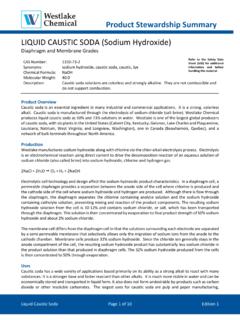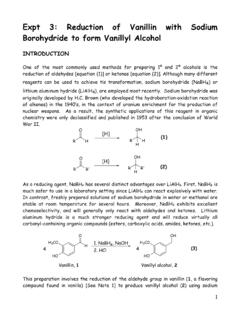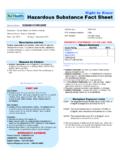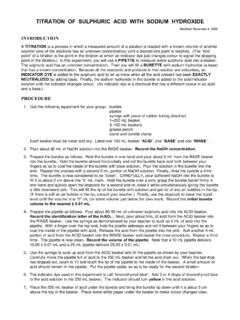Transcription of Safety Data Sheet - Sodium Hydroxide and Potassium ...
1 Safety Data Sheet Page 1 of 5. Sodium Hydroxide , solid SDS for Lye ( Sodium Hydroxide ) printed from Section 1 - Identification SDS Name: Sodium Hydroxide , solid. Synonyms: Lye, Sodium hydrate, white caustic, caustic soda, soda lye, soda ash, ascarite. Company Identification: Certified Lye PO Box 133 Spring Valley, CA 91976-0133 Website: Email: Telephone: 619-668-1435 Poison Control Center: 800-222-1222 Chemtrec: 800-424-9300 Section 2 - Hazards Identification Emergency Overview Appearance: White solid. Danger! Causes eye and skin burns. Causes digestive and respiratory tract burns.
2 Hygroscopic (absorbs moisture from the air). Target Organs: Eyes, skin, mucous membranes. Potential Health Effects Eye: Causes eye burns. May cause blindness. May cause chemical conjunctivitis and corneal damage. Skin: Causes skin burns. May cause deep, penetrating ulcers of the skin. Ingestion: May cause severe and permanent damage to the digestive tract. Causes gastrointestinal tract burns. May cause perforation of the digestive tract. Causes severe pain, nausea, vomiting, diarrhea, and shock. Inhalation: Irritation may lead to chemical pneumonitis and pulmonary edema. Causes severe irritation of upper respiratory tract with coughing, burns, breathing difficulty, and possible coma.
3 Causes chemical burns to the respiratory tract. Chronic: Prolonged or repeated skin contact may cause dermatitis. Effects may be delayed. Section 3 - Composition, Information on Ingredients CAS#, Chemical Name, Percent, EINECS/ELINCS: 1310-73-2, Sodium Hydroxide , 99-100, 215-185-5. 497-19-8, Sodium carbonate, < , 207-838-8. Food Chemical Codex (FCC): These chemicals meet the FDA requirements for food use. Section 4 - First Aid Measures Eyes: In case of contact, immediately flush eyes with plenty of water for a t least 15 minutes. Get medical aid immediately. Skin: In case of contact, immediately flush skin with plenty of water for at least 15 minutes.
4 Immediately remove contaminated clothing and shoes. Get medical aid immediately. Wash clothing before reuse. Ingestion: If swallowed, do NOT induce vomiting. Get medical aid immediately. If victim is fully conscious, give a cupful of water. Never give anything by mouth to an unconscious person. Inhalation: If inhaled, remove to fresh air. If not breathing, give artificial respiration. If breathing is difficult, give oxygen. Get medical aid. Notes to Physician: Treat symptomatically and supportively. Safety Data Sheet Page 2 of 5. Sodium Hydroxide , solid SDS for Lye ( Sodium Hydroxide ) printed from Section 5 - Fire Fighting Measures General Information: As in any fire, wear a self-contained breathing apparatus in pressure-demand, MSHA/NIOSH (approved or equivalent), and full protective gear.
5 Use water spray to keep fire-exposed containers cool. Use water with caution and in flooding amounts. Contact with moisture or water may generate sufficient heat to ignite nearby combustible materials. Contact with metals may evolve flammable hydrogen gas. Extinguishing Media: Substance is noncombustible; use agent most appropriate to extinguish surrounding fire. Do not get water inside containers. Flammability: Nonflammable. Flash Point: Not applicable. Autoignition Temperature: Not applicable. Flammable Limits: Not available. NFPA Rating: Health: 3; Flammability: 0; Instability: 1.
6 Section 6 - Accidental Release Measures General Information: Use proper personal protective equipment as indicated in Section 8. Spills/Leaks: Vacuum or sweep up material and place into a suitable disposal container. Avoid runoff into storm sewers and ditches that lead to waterways. Clean up spills immediately, observing precautions in the Protective Equipment section. Avoid generating dusty conditions. Provide ventilation. Do not get water on spilled substances or inside containers. Section 7 - Handling and Storage Handling: Wash thoroughly after handling. Do not allow water to get into the container because of violent reaction.
7 Minimize dust generation and accumulation. Do not get in eyes, on skin, or on clothing. Keep container tightly closed. Avoid ingestion and inhalation. Discard contaminated shoes. Use only with adequate ventilation. Storage: Store in a tightly closed container. Store in a cool, dry, well-ventilated area away from incompatible substances. Keep away from metals. Keep away from acids. Store protected from moisture. Containers must be tightly closed to prevent the conversion of NaOH to Sodium carbonate by the CO2 in air. Section 8 - Exposure Controls, Personal Protection Engineering Controls: Facilities storing or utilizing this material should be equipped with an eyewash facility and a Safety shower.
8 Use adequate general or local exhaust ventilation to keep airborne concentrations below the permissible exposure limits. Exposure Limits Chemical Name, ACGIH (TLV), NIOSH (REL), OSHA (PEL): Sodium Hydroxide , 2 mg/m3 Ceiling, 10 mg/m3 Ceiling (15 minutes), 2 mg/m3 TWA. Sodium carbonate, none listed, none listed, none listed. NIOSH IDLH Concentration: 10 mg/m3. OSHA Vacated PEL: None of these chemicals have an OSHA Vacated PEL. Personal Protective Equipment Eyes: Wear chemical splash goggles and face shield. Skin: Wear gloves, apron, and/or clothing made of butyl rubber, nitrile rubber, and/or polyethylene.
9 Clothing: Wear appropriate protective clothing to prevent skin exposure. Respirator: A respiratory protection program that meets OSHA's 29 CFR and ANSI requirements or European Standard EN 149 must be followed whenever workplace conditions warrant respirator use. Safety Data Sheet Page 3 of 5. Sodium Hydroxide , solid SDS for Lye ( Sodium Hydroxide ) printed from Section 9 - Physical and Chemical Properties Physical State: Solid. Appearance: White pellets. Odor: Odorless. pH: 14 (5% aq soln). Vapor Pressure: 1 mm Hg @ 739 deg C. Vapor Density: Not available. Evaporation Rate: Not available.
10 Viscosity: Not available. Boiling Point: 1390 deg C @ 760 mm Hg. Freezing/Melting Point: 318 deg C. Decomposition Temperature: Not available. Solubility: Soluble. Specific Gravity/Density: g/cm3. Molecular Formula: NaOH. Molecular Weight: Section 10 - Stability and Reactivity Chemical Stability: Stable at room temperature in closed containers under normal storage and handling conditions. Conditions to Avoid: Moisture, contact with water, exposure to moist air or water, prolonged exposure to air. Incompatibilities with Other Materials: Water, metals, acids, aluminum, zinc, tin, nitromethane, leather, flammable liquids, organic halogens, wool.






